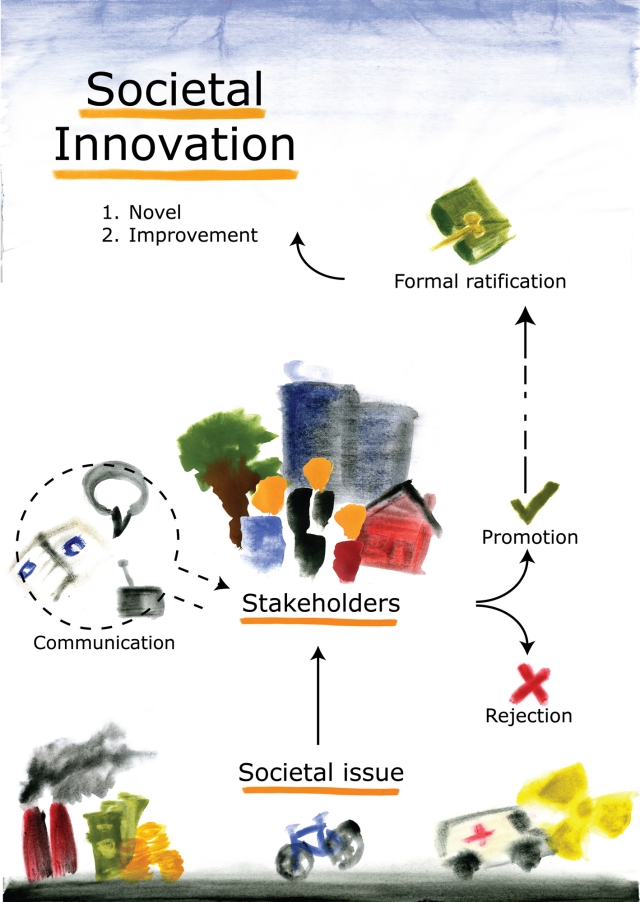The image displays a model where societal innovations grow from the civil society. ACSI is also trying to change the society with this kind of a bottom-up model.
Different societal issues rise into public awareness and gain stakeholders. Some stakeholders engage in active communication in trying to gain more support for the cause, influencing the size of the stakeholder group. If an issue gets enough attention, solutions emerge and are promoted to the level that they may become societal innovations.
Any societal change that emerges needs to disrupt the current equilibrium between the state and the civil society to create a new equilibrium in order to become a societal innovation. Therefore, a formal ratification by the state is needed. This formal ratification can be, for example,
- institutive, e.g. the institutionalization of science in universities, medicine in hospitals, or law-enforcement in police department,
- legislative, e.g. the bill of rights,
- an international contract between the states, e.g. Kyoto climate treaty or the Geneva Convention on human rights, or
- an official recognition, e.g. Copenhagen climate conference.
Not everything is an innovation. Only those societal changes that are novel and make real impacts on society by improving it may be called societal innovations.
The basic idea behind the model is that the amount of text is minimal. Instead, graphics are used to communicate the context and give meaning to the model skeleton. The model itself can be viewed from a variety of perspectives and can be used even for deep analyses.
The model skeleton was created by Ville Lehtola. Juho-Pekka Virtanen drew the graphics. Because this is a draft, feedback is genuinely appreciated!
Similar text in Finnish:
Kuva esittää sitä, kuinka kansalaisyhteiskunnasta ml. ACSI (kuvan alaosa) kasvaa ideoita ja uusia toimintamalleja, jotka vaikuttavat julkisen vallan (yläosa) toimintaan.
Dynaaminen prosessi näyttäytyy grow-mallina, jossa erinäiset yhteiskunnalliset asiat nousevat esille ja saavat stakeholdereita. Stakeholderit itse kommunikoivat ahkerasti (puskaradio, kaupallinen media, sosiaalinen media, jne.) ajaen omaa asiaansa. Kun asia saa tarpeeksi kannatusta, se siirtyy erinäisten vaiheiden jälkeen osaksi yhteiskuntaa ja näin voi muodostaa yhteiskunnallisen innovaation. Tälle ehtona on formal ratification, eli yhteiskunnallinen liike saa aiheelle aikaan tunnustetun aseman.
Formal ratification voi olla
- institutionalisointi, esim. tiede on institutionalisoitu yliopistoon, lääkärit sairaalaan, lainvalvojat poliisiksi,
- lainsäädäntö, esim. tasa-arvo tai ihmisoikeudet
- ylikansallinen sopimus, esim. Kyoton ilmastosopimus tai Geneven ihmisoikeussopimus
- virallinen käsittely, esim. Köpiksen ilmastokokous
Formal ratification muuttaa kansalaisyhteiskunnan ja julkisen vallan tasapainoa (equilibrium of the state and the civil society). Vaikka vallankumouksen voima onkin kansalaisyhteiskunnalla, se tarvitsee julkista valtaa sujuvan arjen luomiseksi.
Teksti “1. Novel 2. Improvement” on muistuttamassa niistä käsitteellisistä ehdoista, joita yhteiskunnallisella innovaatiolla on. Kaikki muutokset eivät ole innovaatioita.
Kuvan pyrkimys itsessään on olla mahdollisimman minimalistinen tekstin suhteen, ja pyrkiä käyttämään grafiikkaa tukena kommunikoimaan viestiä. Kuvassa itsessään on paljon asiaa, jota voi avata eri näkökulmista. Ville Lehtola laati kuvan rakenteellisen luurangon, ja Juho-Pekka Virtanen piirsi 1. version grafiikasta.
Palaute on tervetullutta. Kuva on tarkoitettu matalan kynnyksen malliksi päästä käsiksi yhteiskunnallisiin innovaatioihin. Toisaalta kuvassa oleva prosessin kuvaus mahdollistaa erilaisia syvempiäkin tarkasteluita, siten että kuvan relevanssi säilyy pitkälläkin tähtäimellä.


Change growing from the civil society because it as much is influenced by human behavior. People create communities, it is not society that creates people, so the question becomes; how we create the best conditions for peoples in the community to grow and develop?
Is it so that society-building is not so much about building, but more about planting and nourishment? When we plant, we certainly rarely rest and we have to put up with each season and the new surprises it brings. Human creativity as a resource for societal development cannot be controlled, but it can be facilitated and given better opportunities through infrastructure, venues, rules, and leadership – which, like garden art creators – knows that if the site is to be green there must be room for both sun and rain. Creativity has its cycles.
Community growth and development with and by the people, and not by the established representatives of the society. So how do we creating a sustainable development and an innovative environment that strengthens the Community requires the right soil conditions and growth in the society? What shall we exactly do? How we become a good Gardener?